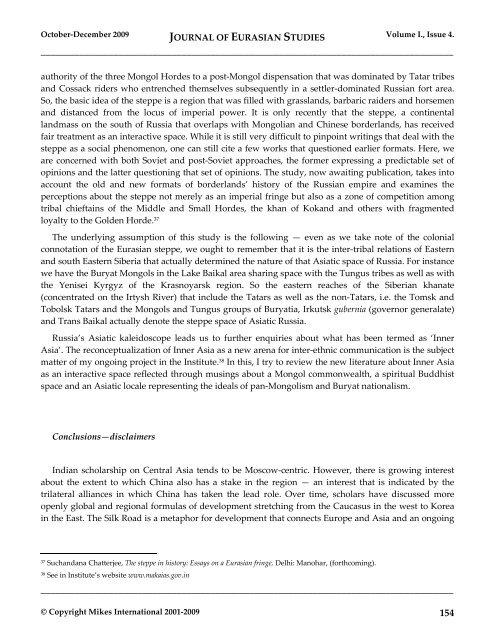JOURNAL OF EURASIAN STUDIES
JOURNAL OF EURASIAN STUDIES
JOURNAL OF EURASIAN STUDIES
Create successful ePaper yourself
Turn your PDF publications into a flip-book with our unique Google optimized e-Paper software.
October-December 2009 <strong>JOURNAL</strong> <strong>OF</strong> <strong>EURASIAN</strong> <strong>STUDIES</strong> Volume I., Issue 4.<br />
_____________________________________________________________________________________<br />
authority of the three Mongol Hordes to a post-Mongol dispensation that was dominated by Tatar tribes<br />
and Cossack riders who entrenched themselves subsequently in a settler-dominated Russian fort area.<br />
So, the basic idea of the steppe is a region that was filled with grasslands, barbaric raiders and horsemen<br />
and distanced from the locus of imperial power. It is only recently that the steppe, a continental<br />
landmass on the south of Russia that overlaps with Mongolian and Chinese borderlands, has received<br />
fair treatment as an interactive space. While it is still very difficult to pinpoint writings that deal with the<br />
steppe as a social phenomenon, one can still cite a few works that questioned earlier formats. Here, we<br />
are concerned with both Soviet and post-Soviet approaches, the former expressing a predictable set of<br />
opinions and the latter questioning that set of opinions. The study, now awaiting publication, takes into<br />
account the old and new formats of borderlands’ history of the Russian empire and examines the<br />
perceptions about the steppe not merely as an imperial fringe but also as a zone of competition among<br />
tribal chieftains of the Middle and Small Hordes, the khan of Kokand and others with fragmented<br />
loyalty to the Golden Horde. 37<br />
The underlying assumption of this study is the following — even as we take note of the colonial<br />
connotation of the Eurasian steppe, we ought to remember that it is the inter-tribal relations of Eastern<br />
and south Eastern Siberia that actually determined the nature of that Asiatic space of Russia. For instance<br />
we have the Buryat Mongols in the Lake Baikal area sharing space with the Tungus tribes as well as with<br />
the Yenisei Kyrgyz of the Krasnoyarsk region. So the eastern reaches of the Siberian khanate<br />
(concentrated on the Irtysh River) that include the Tatars as well as the non-Tatars, i.e. the Tomsk and<br />
Tobolsk Tatars and the Mongols and Tungus groups of Buryatia, Irkutsk gubernia (governor generalate)<br />
and Trans Baikal actually denote the steppe space of Asiatic Russia.<br />
Russia’s Asiatic kaleidoscope leads us to further enquiries about what has been termed as ‘Inner<br />
Asia’. The reconceptualization of Inner Asia as a new arena for inter-ethnic communication is the subject<br />
matter of my ongoing project in the Institute. 38 In this, I try to review the new literature about Inner Asia<br />
as an interactive space reflected through musings about a Mongol commonwealth, a spiritual Buddhist<br />
space and an Asiatic locale representing the ideals of pan-Mongolism and Buryat nationalism.<br />
Conclusions—disclaimers<br />
Indian scholarship on Central Asia tends to be Moscow-centric. However, there is growing interest<br />
about the extent to which China also has a stake in the region — an interest that is indicated by the<br />
trilateral alliances in which China has taken the lead role. Over time, scholars have discussed more<br />
openly global and regional formulas of development stretching from the Caucasus in the west to Korea<br />
in the East. The Silk Road is a metaphor for development that connects Europe and Asia and an ongoing<br />
37 Suchandana Chatterjee, The steppe in history: Essays on a Eurasian fringe, Delhi: Manohar, (forthcoming).<br />
38 See in Institute’s website www.makaias.gov.in<br />
_____________________________________________________________________________________<br />
© Copyright Mikes International 2001-2009 154
















